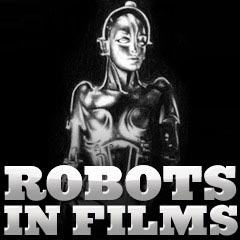
|
A Complete Illustrated History of Robots in the Movies 1998 to 2002 |
| Film/Year, Name of Robot and Film Description | ||||||||

|
Lost in Space (1998)
Robby the Robot, from Forbidden Planet (1956), was the prototype for the heroic, Environmental Control Robot Model B-9 in the Irwin Allen CBS-TV series Lost in Space in the mid-to-late 1960s, and in this widescreen film that also featured the robot. The action was set in the year 2058, with a dying Earth threatened by ecological disaster. The United Global Space Force sent the Robinson Family (loosely based on Swiss Family Robinson) into outerspace. The family was headed by Jupiter Mission lead scientist Professor John Robinson (William Hurt), and included:
The family was on a ten-year mission (in a state of suspended animation) on the Jupiter II spaceship to find a refuge at a habitable planet called Alpha Prime. Terrorist organization Global Sedition's trapped and unwilling stowaway spy Dr. Zachary Smith (Gary Oldman) found himself unconscious and on the launched mission. He had re-programmed and changed the "primary directives" of the "platinum-plated pal" (voice of Dick Tufeld, the original robot's voice), which cried out "Warning! Warning!" The mission's robot became a Cyclops-eyed, 8-foot tall robot - a destructive fighting machine onboard the ship. It reiterated its directive:
Smith added: "Give my regards to oblivion." Dr. Smith's attempt to sabotage the flight by destroying the ship using the robot's laser rays and killing the crew failed when young boy genius Will Robinson was able to control the robot remotely, although the ship was sent off-course and became 'lost in space.' During their further journey, the family came upon carnivorous, heat-seeking, silicon-based killer spider-crab robots with large fangs, that also spewed blue blood, found on a ghostly, abandoned spaceship named the Proteus. Dr. Smith was transformed and mutated into a giant space spider humanoid after being scratched by one of the Proteus spiders. |
  Robby the Robot   Unnamed Cyclops Robot  Humanoid Spider |
||||||
The Outsider (1998) (aka Gangster World) (TV movie)
Director David Bishop's science-fiction TV film was a variation of Michael Crichton's Westworld (1973), about a theme park where western cowboy androids suddenly went crazy. This film was also set in a futuristic theme park, a place where visitors could interact with androids, but in this case as film noir detectives against violent gangsters in a 1930s-1940s mob setting. Many of the character names were those of actors from 1940s film noirs, for example, Garland Widmark, Lita Hayworth, Dr. Greenstreet, Astor, Rains, Houston, Ladd, and two thugs Rath and Bone, etc. The film's tagline was: "Lust, greed and violence...welcome to the future." Vampish android gun moll Astor (supermodel Stacey Williams), the main squeeze of Lorre (Will Leong), spouted lines such as: "How about a tumble before the rumble?", and "Take me with you lover, I'm really good in a tight squeeze." The time period and locale was L.A. in the year 2028. The interactive Gangster World theme park was created by Dr. Greenstreet (David Leisure), as a way to decrease crime ("the civilized way to cope with violence"). Robotic Carbon Units or RCUs (part-human androids) populated the park, and were programmed to not hurt humans. Genius software designer Garland Widmark (Gabriel Dell, Jr.) was hired by Greenstreet to make the park fully-automated. On the eve of the park's grand re-opening when a new master computer (named Donald 3000) went online, there was a major homicidal disaster, possibly the result of sabotage. An assassinator android known as the mysterious Outsider (Adam Kendrick) appeared. He was programmed to kill - and soon human park guards were slain. It was possible that a mysterious Kingpin was behind the malfunctions, or the park's militaristic security head Alan Houston (Lindsay Lee Ginter). When going to investigate inside the park, Widmark's blonde co-worker and romantic interest Lita Hayworth (Bridget Flanery) was abducted and held hostage by android mobsters. Widmark was forced to try and rescue her - although he too was marked for assassination by the Outsider. |

 Astor (Stacey Williams) 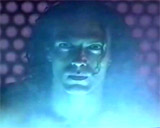  The Outsider (Adam Kendrick)  An Android's Brain |
|||||||

|
Small Soldiers (1998)
Director Joe Dante (responsible for Gremlins (1984)), helmed this dark sci-fi comedy-fantasy-action film that combined animatronics, puppetry (by Stan Winston), and computer animation. It was a hybrid of Toy Story (1995) and the popular supernatural board game Jumanji. It told of the fierce battle in suburbia (represented by quiet Winslow Corners, Ohio) between two factions of sentient beings. They were "small soldiers" - high-tech talking toys militaristically amped-up with computer micro-chips. The fierce-fighting, live-action toys were built by the Heartland Play Systems, a toy company newly-acquired by the defense industry firm of GloboTech Industries:
|
 Chip Hazard - Commando Elite  Commando Elite member  Archer - Gorgonite |
||||||

|
Austin Powers: The Spy Who Shagged Me (1999)
In the second film in the Austin Powers series, newly-wed Vanessa Kensington (Elizabeth Hurley) was revealed to be one of Dr. Evil's FemBots. [See also Austin Powers: International Man of Mystery (1997) above.] She was a "kamikaze bride" with "machine-gun jubblies" (breasts) who attempted to kill husband Austin Powers (Mike Myers) - but she soon self-destructed. |
 
|
||||||

|
Bicentennial Man (1999)
Based on Isaac Asimov's 1883 short story The Positronic Man (only his second writing adapted for the screen), this futuristic robot-related film featured Robin Williams as Andrew Martin, a domestic-household android robot ("appliance") designed to serve humans with the performance of menail tasks. But robot-servant Andrew craved to become fully human, exhibiting human characteristics of "creativity, curiosity, friendship," bridging the gap between man and machine ("I am the proud owner of a central nervous system"). In the cloying, mawkish, and sentimental film, he eventually took on android characteristics and turned himself into a prosthetic human - and at the ripe old age of 200 years was allowed to marry the love of his life Portia Charney (Embeth Davidtz) during his final moments. The model number was thought to be a tribute to Stanley Kubrick, who used the lucky number in several of his films, for example Dr. Strangelove: Or... (1964) and A Clockwork Orange (1971). |
   
|
||||||

|
Futurama (1999- ) (TV series)
Futurama was the first new animated TV series created by Matt Groening since The Simpsons. Accidentally frozen in a cryogenics tube in a laboratory (at the stroke of midnight), 20th century NYC pizza-delivery boy Philip J. Fry (voice of Billy West) woke up 1,000 years in the future (at the dawn of the year 3,000), completely preserved. He was taken in by his sole living relative, Professor Hubert J. Farnsworth (voice of West also) - an elderly mad scientist who owned a small cargo delivery service (intergalactic), the Planet Express. Among the other crew members that were hired were:
|

|
||||||

|
Inspector Gadget (1999)
Director David Kellogg's (feature debut film) and Disney's live-action cartoon film was based upon the early 1980s animated cartoon series (on NBC-TV with 86 episodes over two seasons from 1983-1985), with Don Adams as the voice of the gadgeted Interpol agent. The film was soundly criticized for an assault of numerous product placements. Meek security guard John Brown (Broderick Crawford), employed at Riverton Ohio's Bradford Laboratories, always dreamed of becoming a law-enforcing police officer. He also had a romantic interest in boss Dr. Artemus Bradford's (Rene Auberjonois) scientist daughter Dr. Brenda Bradford (Joely Fisher). During the pursuit of a theft of a mechanical foot, stolen by soon-to-be arch-villain and robotics billionaire Sanford Scolex (Rupert Everett) during a break-in at the lab (that killed Artemus), Brown was badly injured in an explosion. Scolex lost his left hand from a bowling ball falling on his hand after the explosion. (He replaced his hand with a large metal Claw, that became his new nickname: "Just Claw, one word... like Madonna"). Similar to the RoboCop films and the The Six Million Dollar Man, Brown was rebuilt by Brenda as a prototype police officer cyborg - a technological bionic man newly-named Inspector Gadget (Crawford). Brown was initially confused by his new persona ("I'm not me any more, I'm a hardware store"). Police Chief Quimby (Dabney Coleman) quipped: "Columbo and Nintendo all rolled into one." He was dressed with a khaki raincoat, black necktie, and hat - the Gadget Suit, and a mantra of magic words ("Go-go Gadget -- "), which when spoken would invoke a crime detection device (a helicopter, oil-slick, etc.), or cause his body to sprout tools:
He also had a talking car with AI, named Gadget-mobile (voice of D.J. Hughley), that drove itself. Vengeful Scolex, after eagerly stealing gadget technology, built armies of killer androids. He unleashed an evil, android look-alike of Gadget upon the city, named Robo-Gadget (Crawford again). He could be distinguished from Inspector Gadget by his oversized white teeth, and brown and black-striped clip-on tie. His goal was to ruin Inspector Gadget's reputation and then eventually kill him. Brenda also had an evil twin named Robo-Brenda (Fisher again). In their final battle together between Inspector Gadget and his duplicate, Robo-Gadget used tommy guns, scythes, and even a spider to try to defeat the real Inspector, but ended up beheaded. See also the sequel, Inspector Gadget 2 (2003). |
 Inspector Gadget (Broderick Crawford)   Robo-Gadget  Robo-Gadget Decapitated |
||||||

|
The Iron Giant (1999)
Brad Bird's enchanting animated Cold War parable, adapted from poet Ted Hughes' 1968 The Iron Man, told about the friendship between:
The "iron giant" was originally created to be an inter-stellar weapon, but whose nature was changed due to crashing into the ocean during a hurricane. It was capable of munching metal as food, flying, and speaking a few English words. The young boy told the robot after hunters shot a deer and killed it with a gun:
The plot concerned the efforts of odious and villainous federal government agent Kent Mansley (voice of Christopher McDonald) to capture and destroy the misunderstood Giant. In the film's conclusion, the robot was nobly self-sacrificial before an army. ''I am not a gun." He made a climactic, tear-jerking sacrifice to save the small Maine town of Rockwell from a nuclear missile. The Giant soared into the air to neutralize it by striking it head-on, as he heard the words of Hogarth: "You are who you choose to be." Just before the explosion in outer space, the Giant realized his heroism and identity: "Superman!" The Iron Giant was then seen memorialized in a statue in the town of Rockwell, Maine, and last seen in a final shot smiling as he self-repaired on an Icelandic glacier - signaling for all his disassembled parts to regroup. |
    The Iron Giant   "Superman!" 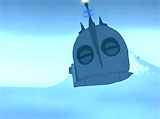 Reassembling - Resurrection |
||||||
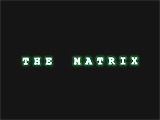
|
In this popular and imaginative, nightmarish sci-fi film (and also in its two sequels) from the Wachowski Brothers, Sentinels were described as "a killing machine designed for one thing...Search and destroy." They were autonomous, multi-tentacled, metallic clawing killing machines (resembling squids or octopi, hence their nicknames "Squiddies" or "Calamari") that relentlessly patrolled the ancient passageways and sewers of the dead human cities, equipped with sensory devices, lasers, bombs, and other weapons. These lethal, fast-moving mechanized nautilus' were covered with red spider-eye-like lenses, manipulative crab-like arms and tentacles with gripping, razor-sharp claws. They floated on anti-gravity generators in order to roam and pursue. In the film's conclusion, Agent Smith (Hugo Weaving) ordered a Sentinel strike against the hovercraft Nebuchadnezzar, after Morpheus (Laurence Fishburne) had been rescued from the Agent's stronghold by the heroic Neo (Keanu Reeves) and vinyl-clad heroine Trinity (Carrie-Anne Moss). An EMP (Electro-Magnetic Pulse) was able to repel the Sentinels before they damaged the craft. |
  Sentinels |
||||||
 
|
Star Wars: Episode I - The Phantom Menace (1999)
Battle droids (aka war droids or killer droids) were designed solely for combat, often in large mass-produced units that marched together. They were tall, thin robotic soldiers with exposed joints and bone-white or rust brown metal finishes that gave them an eerie resemblance to animated skeletons. Like the Storm Troopers in the original trilogy, these dim-witted, infantry droids who carried blaster guns existed as fodder for the heroes to kill off in vast numbers. During the Battle of Naboo in The Phantom Menace, Anakin Skywalker destroyed the Droid Control Star-Ship of the Trade Federation, which housed a central computer control. Thus, the droids were deactivated. |
  
|
||||||

|
Red Planet (2000)
This unsuccessful science fiction thriller film followed a small, six-person team of astronauts on an investigative rescue operation to the red planet of Mars in the year 2045. It was led by pretty Commander Kate Bowman (Carrie-Anne Moss). Their mission was to investigate further terraforming of Mars for future human colonization ("We have to make Mars the future, or mankind is history"). . During a solar flare incident and subsequent shipwreck on the planet, a multi-purpose, unspeaking quadripedal (crouching) or bipedal (7 foot tall) robot named AMEE, an ex-military android (completely CGI-created) designed for mapping and exploration of the Martian surface, was damaged in the crash and reverted to its original programming as a hunter/killer. The android stalked the crew members with its infra-red and X-ray vision. The metallic, skeletal monkey-like AMEE had four limb appendages with joints that swiveled, turned, pivoted, and spun around, and clawlike 'fingers'. |
   
|
||||||

|
A.I.: Artificial Intelligence (2001)
Steven Spielberg's futuristic science-fiction fairy tale was based on Brian Aldiss' short story 'Super-Toys Last All Summer Long.' It starred Haley Joel Osment as 11 year-old Pinocchio-questing David, a Cybertronics android child "mecha" (robot of the future), with an 'animatronic' robotic teddy bear named Teddy (voice of Jack Angel). It had a similar plot-line retelling Disney's Pinocchio about a search of a puppet to become a real boy and find real love. Through irreversible imprinting, David believed he was capable of real emotion and unconditional love toward his adoptive mother Monica Swinton (Frances O'Connor) and father Henry Swinton (Sam Robards), although when their real son Martin (Jake Thomas) recovered from a state of suspended animation, David was eventually abandoned. Rather than being returned to Cybertronics for destruction, David was forced to take a long journey to become "real" by encountering the "Blue Fairy" (a submerged Coney Island statue, actually) from the Pinocchio tale. He believed that if the "Blue Fairy" could make him "real," his mother would love and accept him forever. During his adventures, David met up at the Flesh Fair with to mecha robots, male and female pleasure mecha robots by design, able to change their hair color or accent based on clients' needs:
Joe reassured client Patricia (Paula Malcolmson) in a mirrored room before making love: "Once you've had a lover-robot, you'll never want a real man again." Joe also made a contemptuous statement to David about the humans who had made him:
David eventually learned the horrifying truth that he was a mecha-nical robot boy who could never be transformed into a real human, and that many copies of himself were being manufactured. He was not unique, real, special, or even human. By film's end about 2000 years later in a tacked-on epilogue, David was able to experience a poignant one-day reunion ("one perfect day") with his adoptive human mother Monica, reconstructed or resurrected from DNA found in a lock of her saved hair. They laid down together at the end of the day, when she finally told David that she loved him, and he felt special and real. |
 David  Gigolo Joe (Jude Law)  Gigolo Jane (Ashley Scott)  Gigolo Joe and David  The Blue Fairy  David with Monica |
||||||
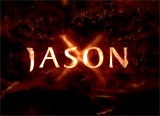
|
Jason X (2001) (aka Friday the 13th, Part 10)
In the tenth installment of the horror/slasher film series franchise set in the year 2455, a "knowledge matrix android" named KAY-Em 14 (Lisa Ryder) helpfully analyzed the frozen and masked corpse of a cryogenically-frozen Jason Voorhees (Kane Hodder), declaring it a "humanoid." Jason's hockey mask was determined to be "Facial armor, used in a sport outlawed in 2024." She also was the love interest of one of the archaeology students named Tsunaron (Chuck Campbell), who helped her position fake nipples on her prosthetic breasts, but they fell to the floor. She asked him: "Do you like them?" Her responded: Later in the film, she was upgraded with an "uploaded" program - transformed into a formidable kick-ass killer droid with combat skills - carrying oversized, lethal weapons and wrapped in bands of bullets ("I'm afraid I'll have to hurt you now," she threatened Jason). By film's end, she had been decapitated by an Uber-Jason, but was still functioning, and looking forward to having a new body: |
 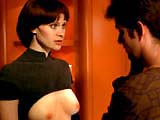   KAY-EM 14 (Lisa Ryder) |
||||||

|
Metropolis (2001, Jp.)
This Japanese anime film by director Rintaro was ultimately inspired by Fritz Lang's classic silent film of the same name, Metropolis (1927, Germ.), with some resemblances to Dark City (1998) and Ridley Scott's Blade Runner (1982). The movie was scripted by writer-director Katsuhiro Otomo (Akira (1988, Jp.)), who was working from the 1949 manga comic created by the father of modern Japanese manga (or "father of anime") - Osamu Tezuka, who was also the creator of the comic series Astroboy. Although the film excelled in its dazzling visuals and animation, its plot was often slow-paced and dull with undeveloped characters. The story was set in the futuristic city of Metropolis, in which both robots and humans lived but not entirely in peaceful co-existence - separated by levels and/or societal segments. Robots - considered downtrodden second-class citizens, lived in a segregated, underground world, while humans lived the good life. The city was ruled by a conniving industrialist known as Duke Red (Tarô Ishida). The rich, ambitious megalomaniacal industrialist had hired rebellious scientist-genius, Dr. Laughton (Junpei Takiguchi), to create a perfect robot girl for him - an innocent mecha-girl named Tima (Yuka Imoto). She was modeled after Red's own deceased daughter. Laughton bragged to Duke Red about his invention (to be completed by the end of the week), with only her fuel-management systems still unstable:
Duke Red's intent was to have Tima, the ultimate robot android "superhuman " (created to be his powerful weapon) sit atop his massive skyscraper known as the Ziggurat (a Tower-of-Babel like structure) and rule the world from his throne. However, the devious and scheming Laughton was also secretly planning to leave Metropolis with his own invention, without ever handing it over to the Duke. Duke Red's heartless adopted son (an orphan), a jealously-protective young aide named Rock (Kôki Okada), headed up a vigilante group known as the Marduk Party, to put down any uprisings or rebellion (mostly anti-robot sentiment) by eliminating rogue robots. Following his own cold-blooded path, Rock lethally shot Dr. Laughton, and set his laboratory on fire, hoping to destroy both him and the robot - because of his profound jealousy: "No mechanical puppet is going to steal my father's heart...I won't allow my father to be fooled by a robot" - he vowed. His objective was to protect his father "from the evil of machines." Meanwhile, Japanese private detective Shunsaku Ban (Kōsei Tomita) and his Tin-Tin-like sidekick nephew Kenichi (Kei Kobayashi) became involved when they went searching for rebel scientist Dr. Laughton, to seize his latest unfinished creation - Tima. Kenichi found himself on an odyssey with the incomplete robot girl (unaware of who she really was: "Who am I?"), protecting her and teaching her to speak. |
 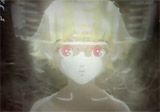     Tima |
||||||

|
The Adventures of Pluto Nash (2002)
This directionless effort, that wasted both time and talent, seemed promising at the start, with a competent director (Ron Underwood had already directed Mighty Joe Young (1998), Tremors (1989) and City Slickers (1991)), and a great cast for both supporting roles and short cameos. However, it suffered possibly one of the largest financial losses (percentage-wise) ever recorded for a film -- approximately a 95% loss. The film's infantile and unfunny script was poorly executed and borrowed from lots of second-rate films. It was filmed episodically like a vintage action serial, was dwarfed by the inventive production values of the film's setting and special effects, and was often diluted by Eddie Murphy's familiar but sleepy and subdued characterization. The film was honored with five Razzie Award nominations: Worst Actor (Murphy), Worst Director, Worst Picture, Worst Screen Couple, and Worst Screenplay. It was also nominated in 2005 as the Worst 'Comedy' in 25 years of Razzie awards, losing to Gigli (2003). Its story was about an ex-smuggler and ex-con nightclub owner in space (on the Moon 239,000 miles from Earth) around the year 2087 named Pluto Nash (Eddie Murphy). Nash had bought a bar from his lounge lizard Italian friend Tony (Jay Mohr) and turned it into a successful nightclub, known as Club Pluto (in the hip urban district of "Little America" - a lunar Las Vegas). He was pressured by demanding mobster goons (including Joe Pantoliano as thuggish hitman Mogan and Kelp (Victor Varnado)) to turn over his successful establishment for $10 million to reclusive and mysterious gangster kingpin Rex Crater. Crater resided in a penthouse at the swanky Lunar Grand Casino in the gambling city of Moon Beach. Crater wanted the club to be converted into a lucrative casino. When the mob blew up the nightclub and engaged in a laser-gun shootout, Nash became a fugitive with his new love interest: his own space-suited waitress and aspiring nightclub singer Dina Lake (Rosario Dawson) during her first visit to the Moon. For the remainder of the film, Nash sought to find out the identity of the mysterious magnate (Rex Crater) in order to seek revenge - in the film's spoiler, Nash's evil nemesis was revealed to be Pluto himself - a 7 year old clone. Nash was always joined by his outdated, hulking robot bodyguard named Bruno (Randy Quaid), an inferior Model 63 Deluxe android looking like a gray Frankenstein. With his shaved bald head, thick grease-pencil eyebrows, lumbering stride, and badly-stitched suit, the vintage Bruno with a Midwestern accent always had a smile on his face due to a happiness-chip implant. |
  Bruno (Randy Quaid) |
||||||

|
Minority Report (2002)
Director Steven Spielberg's futuristic, sci-fi mystery thriller, based on a short story by Philip K. Dick, was set in the year 2054. Pre-crime law enforcement used psychic 'precogs' who were submerged in flotation tanks to forecast and envision future crimes. However, it appeared that 'pre-crime' was a flawed system, because the three 'precogs' didn't always agree (a discrepancy in their visions would be written up - called a 'minority report' - the film's title). In a suspenseful set of sequences, Washington DC pre-crime cop Capt. John Anderton (Tom Cruise), who had misgivings about the 'pre-crime' system, was forced to become a fugitive (he was undoubtedly framed) when he was identified as the future killer of a person he didn't know - a person named Leo Crow. He kidnapped one of the precogs, Agatha (Samantha Morton) as he went on a quest to vindicate himself and locate the future victim. During a full-scale search, Anderton hid in a tub of ice water in a tenement building. One of the patrolling officers noted with a thermal scan that there were 28 warm bodies: "I confirm 28 warm bodies... What do you think - four spiders, one per floor?" Mechanical bot-spyders, with polywog-like spherical bodies with tails, were stored in each officer's belt with their legs retracted. They were released to swarm through the entire area, and to perform retinal scans on the tenants to determine identities from eyeballs - to find out whether Anderton was there or not. When Anderton emerged from the water and removed part of his blindfold, one of the spyder-bots scanned his retina. He knew he wouldn't be identified ("It's not him"), because he had just undergone eye replacement surgery.
The film concluded with a twist, proving that Anderton had been framed within his own department. His corrupt pre-crime boss Lamar Burgess (Max von Sydow) was revealed to be the murderer of Agatha's mother Anne Lively (Jessica Harper). The motive for the drowning was because Anne, who had conquered her drug habit, had wanted to remove her fragile pre-cog daughter Agatha from the pre-crime flotation tanks. Threatened by the thought, Burgess wanted to prevent the shut-down of his sinister, futuristic law enforcement organization. When his crime was discovered, Burgess committed suicide. |
 Spyder-Bots  Blindfolded Anderton (Tom Cruise) Submerged in Tub of Ice Water  Spyder-Bot Hovering Just Above Water Level |
||||||

|
The Santa Clause 2 (2002)
This romantic comedy was the second part of a trilogy-franchise, beginning with The Santa Clause (1994), and ending with The Santa Clause 3: The Escape Clause (2006). With a budget of $65 million, the sequel cost nearly three times what the first film did. In the first part of the story, divorced father Scott Calvin (Tim Allen in his feature film debut) was forced to take Santa's place when the red-costumed, white-bearded St. Nick fell off his roof. He assumed Kris Kringle's duties due to a legal requirement known as the "Santa Clause." In the sequel, 46 year-old Calvin had been on the job as Father Christmas for eight years. However, he learned that Christmas would disappear and he would lose his magical powers if he didn't find a suitable Mrs. Claus mate by the next Christmas Eve. Meanwhile back at his hometown, Scott's 16 year-old son Charlie Calvin (Eric Lloyd) was 'acting out' and becoming a discipline problem at school (and he had been put on the "Naughty" list). He was charged with vandalism - defacing with graffiti the walls and lockers of his school, presumably due to the prolonged absences of his father, and the added pressure for Charlie to keep his father's identity a secret. During Santa's search for a wife, a robotic duplicate, clone or doppelganger was created of Scott at the North Pole, dubbed the Toy Santa (also Tim Allen). This evil Toy Santa, a mean, life-sized plastic taskmaster outfitted in a military dictator's uniform, believed that every child was "naughty," and the only gifts the next year would be lumps of coal. He announced to all of his dismayed workers:
He also revealed that he had created an army of life-size Toy Soldiers in his image: "They don't have a good sense of humor, like me. I would do what they ask you, which is pretty much what I'm gonna tell ya." The Fake Santa instituted a dictatorship during his coup d'etat, complete with enlarged Toy Soldiers marching around to enforce his will. Bernard (David Krumholtz), the head elf, protested, but to no avail when he was promptly arrested. Scott had romantic luck with Principal Carol Newman (Elizabeth Mitchell), and they became passionately and romantically involved with each other. However, he was forced to return to the North Pole and subdue the evil Toy Santa, who was wreaking havoc and about to destroy Christmas. The Toy soldiers were defeated during a final battle between their robot army and the Elves with snowballs, silly string and snowmobiles, and Toy Santa was reduced to his normal 6" height. |
 Toy Santa (Tim Allen)    Toy Soldiers  The Return of the Real Santa Clause (Tim Allen) |
||||||

|
S1m0ne (2002) (aka Simone)
Writer/director Andrew Niccol's fantasy Hollywood film satirized synthetic celebrities and their promoters. During the filming of big-budget director Viktor Taransky's (Al Pacino) latest feature film titled Sunrise Sunset, the production was on the verge of collapse when his narcissistic and bitchy main star Nicola Anders (Winona Ryder) ("a supermodel with a SAG card") walked off the set. He was also fired by his ex-wife Elaine (Catherine Keener) who was the studio head of Amalgamated Film. Dying, one-eyed geeky software designer Hank Aleno (Elias Koteas) proposed a non-human ("Who needs humans?"), computer-simulated, virtual leading lady as an alternative, found on a computer Zip disk labeled Simulation One, i.e., Sim One -- "Simone." Director Taransky, who had been Oscar-nominated twice as director, was out to prove - almost like Victor Frankenstein - that he could make a film without a real star ("We have stepped into a new dimension. Our ability to manufacture fraud has exceeded our ability to detect it"). The fraudulent film became a smash-hit, but no one had ever seen the pretty, thin, and leggy enigmatic blonde starlet Simone offscreen (real human actress Rachel Roberts in her film debut, although digitally reworked), even after she won the Academy Award for Best Actress. The CGI, digitized star described herself as "the death of real," although one reviewer described her as possessing "the voice of a young Jane Fonda, the body of Sophia Loren, the grace of, well, Grace Kelly, and the face of Audrey Hepburn combined with an angel." Viktor attempted to conceal his charade, going as far as trying to destroy his creation, although his efforts backfired and she was revived. |
   S1m0ne |
||||||
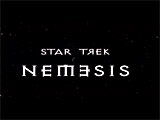
|
This Star Trek Next Generations film was the 10th feature film in the Star Trek franchise and the fourth and last of the Star Trek films to feature the main cast of the Star Trek: The Next Generation TV series. During the USS Enterprise's (NCC-1701-E) journey while it was being captained by Captain Jean-Luc Picard (Patrick Stewart), a positronic signal was received from the Kolarun System and the desert-like third planet of Kolarus III. Android Lt. Cmdr. Data (Brent Spiner) surmised that the signal (coming from six different locations on the surface) could only be from an android ("a long-lost relative?") made by Data's own creator - Dr. Noonien Soong. The Enterprise's shuttlecraft Argo landed and navigated the terrain in its auxiliary dune buggy, finding six disassembled body parts of a look-alike Data android - it was an earlier less-developed and less-advanced prototype named B-4. [Note: B-4 was one of the five other androids built by Dr. Soong before Lore and Data - effectively B-4 was Data's older brother.] The group returned to the ship with the six parts of the B-4 android (to be reassembled), not knowing that they had unknowingly introduced a spy by bringing the disparate parts of the 'planted' B-4 android onboard. Later on, Picard learned that the Enterprise's computers had been accessed. His main adversary, Praetor Shinzon (Tom Hardy) of Remus, had been able to obtain the disassembled B-4 and placed some special programming into him, so he could infiltrate the USS Enterprise-E to gain tactical information about the Federation from the ship. Both the B-4 android and Picard were transported over to Shinzon's ship, to download all of the B-4's information about Starfleet's communication protocols, and to restrain Picard (to take blood samples). Picard had been targeted by Shinzon because the Reman was dying of genetic degeneration and could only be restored with a complete blood transfusion from Picard ("the only donor with compatible DNA"). Shinzon had plans to conquer the Federation ("My life is meaningless as long as you're still alive... We are a race bred for war and conquest"). The story's turning point was the revelation that B-4 was actually being impersonated by Data. Data had deactivated B-4 for an indefinite period because of his potentially dangerous capabilities. Data was also able to release Picard as prisoner - and then he described how he had cleverly given the Remans false information. In the film's climactic struggle onboard the Reman's Scimitar, Shinzon's predatory Warbird spacecraft, Data self-sacrificially remained on the Scimitar to save all the others, and gave his own single-use personal transporter to Picard before saying goodbye. When the warship was blasted into oblivion, Data also lost his life. However, Data would live on. In Data's quarters, Picard realized that Data's prototype 'brother' B-4 probaby hadn't comprehended the loss or understood Data's desires to always want to be better - until B-4 began singing softly to himself the words to "Blue Skies": "Never saw the sun...Never saw the sun..." -- optimistically signifying that he had assimilated Data's memories successfully and would carry on after him. One day, Data would return. |
 Lt. Cmdr. Data (Brent Spiner)  B-4's Head Before Reassembly  Data Deactivating B-4  Data Saying Goodbye to Picard  Last Scene: Picard with B-4 |
||||||

|
Treasure Planet (2002)
Disney Pictures' attempted to provide an animated futuristic version of Robert Louis Stevenson's classic 1883 literary novel Treasure Island -- also Disney's first all-live action feature film in 1950 with Bobby Driscoll and Robert Newton. This expensive film was targeted at family audiences (but would mostly appeal to tween boys, the reverse of the market targeted with its earlier effort Lilo & Stitch (2002)). Unfortunately for Disney, it was a very costly failure, although it was a landmark film -- it was the first film to debut in both the conventional and IMAX formats on the same day. This impressive and stunning animation drastically altered the traditional pirate-themed elements from the original, with the additions of space-wars components, a mythical planet and various space creatures. Its coming-of-age story about filial bonding, bravery and sacrifice told about a troubled, pony-tailed, earring-wearing teen with an attitude named Jim Hawkins (voice of Joseph Gordon-Levitt) who dreamed about a legendary planet called "Treasure Planet." There, treasure had been reportedly hidden by notorious ancient space pirate Captain Nathaniel Flint. With a 3-D holographic treasure map or star-chart issuing from a hand-held spherical orb in his possession, and a space vessel hired by goofy, canine-like family doctor/astrophysicist Doctor Delbert Doppler (voice of David Hyde Pierce from TV's Frasier), the two commenced an intergalactic quest-journey. On board the majestic space galleon RLS Legacy were these crew members:
On Treasure Planet itself (actually a large space station commandered by Captain Flint), the group of fugitive crew members met one of its strange space creatures - a malfunctioning, absent-minded, talkative, abandoned robot named B.E.N (voice of Martin Short) - the film's only fully CGI character (inspired by the novel's character, Ben Gunn). Formerly, B.E.N. was Captain Flint's navigator until Flint stranded him on Treasure Planet. He admitted his memory disability after Flint had removed his memory chip (his eyes were greenish yellow):
Once a piece of B.E.N.'s missing cognitive functioning was replaced, the robot rebooted (his eyes now turned blue) and he remembered that the treasure was located buried in the centroid of the mechanism (space station). However, he also revealed that Flint had created a self-destruct mode (to prevent the loot from being stolen) and if the treasure was taken, the planet was programmed to explode. In the exciting conclusion, the RLS Legacy was able to escape from the exploding planet by the heroic actions of Jim on a turbo-propelled, surfing skateboard. |
 B.E.N. 
B.E.N. with Morph  B.E.N. Rebooting  John Silver 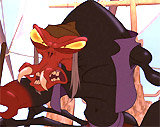 Scroop |
||||||